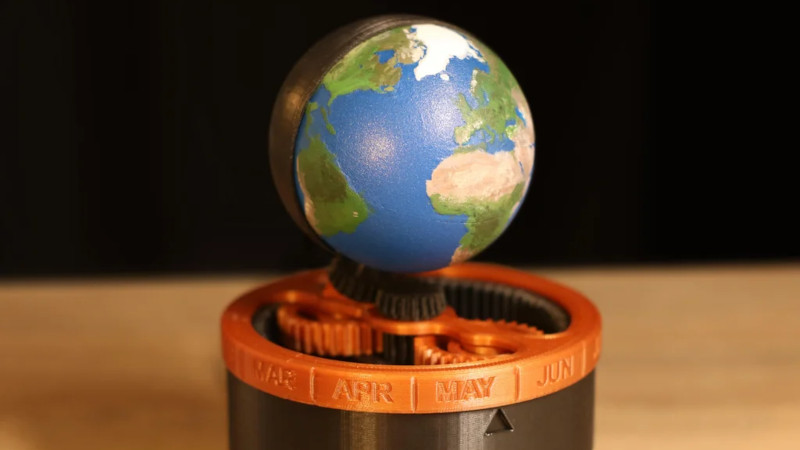Plenty of clocks around us are useful for telling us the precise hour, minute, and second of the day. However, few can give us an intuitive sense of how far away we are from the enveloping cloak of night. This 3D printed Earth clock built by [Simon Rob] promises to do just that.
The build consists of an Arduino Nano driving a stepper motor, which turns a 3D printed model of the Earth through 360 degrees each day. The Earth is rotated within a black shroud such that the current portion of the Earth seeing sunlight is the visible section on the clock, while the rest is hidden from view. There’s a three-stage planetary gear reduction which turns a date wheel connected to the black shroud so that the clock remains accurate throughout the year. The gear ratio isn’t perfect — [Simon] calculates its drift to be 20 hours over a year -but it’s close enough for the clock’s given purpose of being a cool thing.
The clock looks great, and a lot of that is down to [Simon]’s careful work painting the Earth to match the real thing based on Google’s satellite maps. Incidentally it’s not the first Earth clock we’ve seen, either. We might just have to get building one for our own coffee table at home. Video after the break.
















Cool idea but “The gear ratio isn’t perfect — [Simon] calculates its drift to be 20 hours over a year -but it’s close enough for the clock’s given purpose of being a cool thing.” So you’re drifting multiple time zones per month andi in 7-8 months have completely inverted night and day? I do love the idea, but that’s not nearly close enough for the given purpose of being a cool thing. You’d have to re set the time every time you want to show it off, in which case what’s the point.
And it’s sad because it’s something that could easily be fixed in software given the existing gear ratios.
And then it seems to nothing at all to factor in the tilt (and varying hours of light and dark caused by that).
If I read the actual post with the calculations correctly, the black shroud is accurate. It is the month wheel that is losing 20 hours per year, i.e. it will take a couple of years before the drift is visible.
Hi I am Simon :) thanks for your thoughts! indeed, as jpa said, the 20 hours shortage is on the month wheel, Day and night on the globe won’t be inverted, they should stay accurate during a long time.
in other words, if you leave the clock for 36 years without touching it, The globe will continue to face the right way but the month wheel will be late by 1 month.
given this error, I think it would be overkill to design a mechanism for the drift of the tilt doing one revolution each 26000 years. Thanks again ;)
Now if you really want to go to the next step, factor in cloud cover!
All I would change is making the black shroud translucent so you can see who is in night. (And for super points but little LEDs in the locations of large cities that light up at “night”.)
Nice idea indeed
Or planet is not delicate, the thin smear of organic matter on its surface is, but not anywhere near as much as some would suggest.
Remember bacteria that eat rock have been found 6 miles below the surface of the earth. You could probably burn the surface clean and once it cooled down life would recolonize it.
The black shroud depicts situation during equinoxes. But on every other day situation differs from what the (otherwise very nice) clock suggests.
I wonder what would it take mechanically to factor in the fact that day length changes at given latitude during seasons.
Hi, In fact on the model, the earth is tilted and that tilt is slowly turning through the year, So it is already representing that day length change!